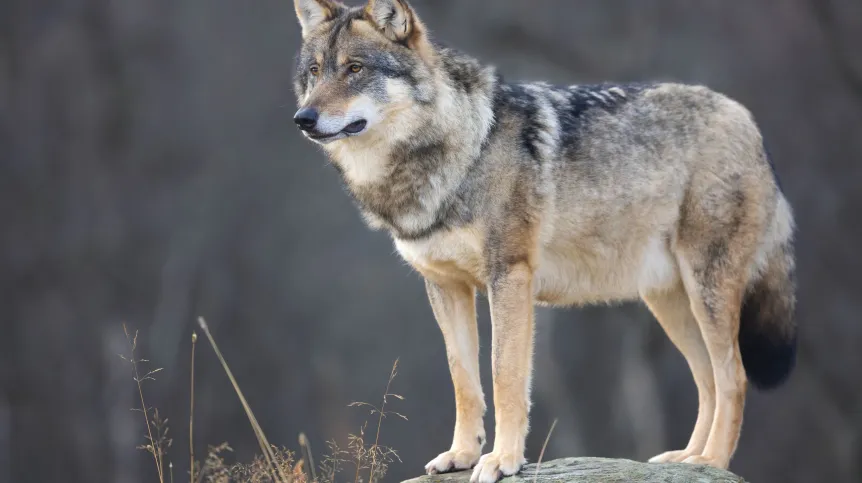
Many reports of wolf attacks on animals are simply fake news, says mammal expert Katarzyna Kozyra-Zyskowska, PhD. She emphasises that people currently have no reason to fear wolves.
The European Parliament votes on changes to the EU Habitats Directive. It may finally seal the weakening of the wolf's protection status - from a strictly protected species, this predator will become a protected species. The wolf would then no longer be subject to strict prohibitions on deliberate capture, killing, disturbance, deterioration or destruction of breeding and resting areas of wolves. It will also be possible to conduct controlled culling (population control) of these predators, in accordance with the regulations of individual countries.
'Many articles (especially in regional media) that demonise wolves and describe their alleged attacks on humans or farm animals are additionally accompanied by AI-generated photographs. This is intended to increase their credibility and intensify fear of wolves in society', says theriologist (mammal specialist) Katarzyna Kozyra-Zyskowska.
In her opinion, these reports spread disinformation about wolves. They are created by groups that want to weaken wolf protection in Poland and the European Union. An example is the April report in regional media in Podlasie (and on a national website) about a human being bitten by wolves. It was denied by the Regional Directorate for Environmental Protection in Białystok.
'Fear of wolves is evolutionarily rooted - for thousands of years, humans have perceived large predators as a potential threat. Additionally, for centuries, a negative image of the wolf has been perpetuated in myths, fairy tales and folk tales, presenting it as a symbol of evil, cunning and danger. We have been bombarded with images of the +bad+ wolf since childhood - an example is the fairy tale +Little Red Riding Hood+', Kozyra-Zyskowska explains.
She adds that as a result, the wolf has become a fearsome creature in the collective imagination, often completely detached from biological and ecological reality.
According to the expert, the negative attitude towards this species deepened with the change in people's lifestyle - from nomadic to settled, agricultural, when we started breeding cattle, sheep, horses. People then encountered wolf attacks on farm animals. Because of these losses, hostility of local communities towards these predators emerged.
'Wolves were also perceived as carriers of rabies, which increased fear of them and determination to exterminate them', Kozyra-Zyskowska says. Mass wolf hunting was facilitated by the development and production of firearms during the industrial revolution; hunting began to be treated as a sport. In addition, the development of agriculture and deforestation, as well as increasing human pressure on the natural environment, contributed to a significant reduction in wolf habitats.
All this led to the almost complete extermination of this predator in Poland at the end of the 19th century. The partially revived population was being exterminated over subsequent decades during the Polish People's Republic to such an extent that in the early 1970s there were only 100 wolves left in Poland. This is how the authors of the paper 'Possibilities of protecting the wolf in Polish national parks', published in 1997 in the journal Morena, which publishes studies and materials from the Wielkopolska National Park, described the situation.
Kozyra-Zyskowska reminds that thanks to legal acts such as the Bern Convention established in 1979 or the EU Habitats Directive of 1992 and social initiatives (including the activities of the Workshop for All Beings), when active protection of wolves became possible throughout the country in 1998, the wolf population began to recover.
'Various activities, both at the international and national level - including legal acts, habitat protection programmes and the involvement of non-governmental organizations - contributed to the gradual recovery of the wolf population in Poland and other European countries', she says. She adds that the wolf population has increased to 21,500 individuals in the EU (and approx. 3 thousand in Poland), which means an increase by 58 percent over the last ten years.
'Wolves are naturally timid and avoid contact with people. In exceptional cases, they may behave unusually - for example, when they become accustomed to the presence of humans (i.e., undergo so-called habituation), or contract rabies. However, it should be emphasised that rabies does not currently occur in wolves in Poland, thanks to effective preventive programs', the theriologist says.
She explains that a wolf attack can occur in special circumstances, e.g. when the wolf was previously fed and tamed by humans. However, such cases are very rare and since the wolf was placed under strict protection in Poland, only two such incidents have been recorded, both in 2018, and in both cases they concerned wolves previously fed by humans. Meanwhile, dog bites in Poland occur at a frequency of 13 cases per 100,000 inhabitants. Despite this - as she emphasises - we are much more afraid of wolves than dogs.
When it comes to wolf attacks on cattle and farm animals, the expert says that, for example, out of 60 million sheep registered in the EU, only 0.065% are killed annually as a result of attacks by these predators. 'Only 0.003% of the cattle population in Poland dies as a result of wolf attacks. The vast majority of farm animal mortality cases are due to other factors, including primarily diseases, accidents and neglect', Kozyra-Zyskowska explains.
She adds that some of the described cases of attacks on farm animals are caused by free-roaming dogs, but they are incorrectly attributed to wolves. Domestic dogs, especially those left unattended, can cause damage to the natural environment, which is confirmed by numerous data from monitoring conducted in various parts of the country. An example is a camera trap recording showing a pack of dogs chasing a moose, which was presented by the researcher during one of the webinars devoted to the issue of wolves.
The fact that wolves rarely attack farm animals is also evidenced by the results of the latest Polish studies. Scientists from the Faculty of Biology of the University of Warsaw have shown during their research in the Warta River Mouth area that wolves feed primarily on wild ungulates - they constituted nearly 82 percent of the biomass of food consumed by them. The share of beavers and hares in the diet of these predators was 14.5 percent. Domestic animals were rarely eaten, and cattle constituted only 3 percent of the food base. A paper on this subject was published in the European Journal of Wildlife.
Kozyra-Zyskowska points out that many people feel fear when they see a wolf on the road or near buildings. 'As a rule, these are young wolves that are very curious, or in the process of searching for a partner and their own territory (so-called dispersion). Wolf habitats are heavily fragmented by road infrastructure, buildings and other elements of the landscape transformed by humans. As a result, during migrations - especially in the case of young individuals searching for new territories - wolves may appear in places where no one would expect them. However, this does not indicate the audacity of the animal. The presence of a wolf in an open landscape, for example in a field, often causes concern, although an analogous situation involving a roe deer does not cause similar emotions, despite the fact that wolves naturally hunt hoofed mammals, and fields are part of their hunting area', she explains.
In her opinion, disinformation in the media concerning wolves causes a lot of harm, because it is difficult for people unfamiliar with the biology and behaviour of these predators to distinguish between facts and fiction. 'Fake news leads to an increase in fear of the wolf and aversion to it. They increase social acceptance of weakening the protection of this predator. Meanwhile, the wolf is neither good nor bad, it is simply a part of the ecosystem in which it plays an important, natural role', the theriologist says.
She emphasises that each of us can combat fake news, e.g. by not disseminating it or demanding corrections from the authors of false media reports.
'In the event of encountering a wolf in the field, you should remain calm. Although it may seem that the animal is staring at you, this is rather due to its limited ability to see. However, when it senses you with its much better sense of smell, it usually quickly moves away', Kozyra-Zyskowska explains. She adds that it is enough to raise your hands or shout to scare this predator away.
To reduce the risk of wolves approaching buildings, it is best not to leave food scraps near houses, secure waste containers, close gates well, seal fences, lock farm animals and dogs at night.
The expert reminds that in Poland there is a system of subsidies for farmers who have suffered damage as a result of wolves' activities. Under the current regulations, it is possible to shoot problematic wolves with the approval of the General Director for Environmental Protection.
Joanna Morga (PAP)
jjj/ bar/ ktl/













